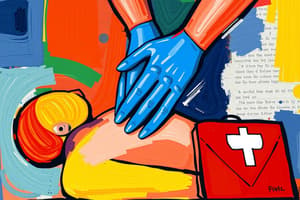Podcast
Questions and Answers
What percentage must be achieved to pass the Red Cross test?
What percentage must be achieved to pass the Red Cross test?
- 80%
- 60%
- 75% (correct)
- 70%
On what date is the first attempt of the Red Cross test scheduled?
On what date is the first attempt of the Red Cross test scheduled?
- January 19, 2025
- January 22, 2025
- January 21, 2025
- January 20, 2025 (correct)
If a student does not achieve 75% on the first attempt, when is their second attempt scheduled?
If a student does not achieve 75% on the first attempt, when is their second attempt scheduled?
- January 22, 2025
- January 21, 2025 (correct)
- June 10, 2025
- January 20, 2025
What consequence does a student face if they do not achieve 75% on both the first and second attempts?
What consequence does a student face if they do not achieve 75% on both the first and second attempts?
What is the total number of questions on the Red Cross test?
What is the total number of questions on the Red Cross test?
Flashcards
First Red Cross Test
First Red Cross Test
The first Red Cross test counts towards your course grade.
Passing Score
Passing Score
You need to achieve at least 75% to pass the Red Cross test.
Second Attempt
Second Attempt
If you don't pass on the first try, you have a second chance on Jan 21st.
Third Attempt
Third Attempt
Signup and view all the flashcards
Make-Up Test Date
Make-Up Test Date
Signup and view all the flashcards
Study Notes
CPR Ratios
- Compression-to-breath ratio for adults, children, and infants in CPR is 30:2.
Heart Attack Causes
- Blocked blood flow to the heart, often due to plaque buildup in coronary arteries.
AED Use
- Ensure no one is near the victim when using an AED.
- Avoid using AEDs in water or near flammable substances.
Signs vs. Symptoms
- Signs are observable, such as a rash.
- Symptoms are felt, such as pain.
Scene Safety
- Ensure the scene is safe before approaching a victim.
Bandage vs. Dressing
- A dressing covers the wound.
- A bandage holds the dressing in place.
First Aid Legal Protection
- Good Samaritan laws protect first aid responders.
First Responder Role
- Provide care until professional help arrives.
Shock Signs
- Pale, cool, clammy skin
- Rapid pulse
- Weakness
- Confusion
Heat Exhaustion Treatment
- Move to a cool place.
- Hydrate.
- Apply cool compresses.
Unresponsive Adult Care
- Check for breathing.
- Call 911.
- Start CPR if necessary.
AED Pad Placement
- Place one pad on the chest and one on the back.
When to Call 911
- Life-threatening emergencies.
- Severe injuries.
Red Cross Symbols
- Red Cross
- Red Crescent
- Red Crystal
Concussion Management
- Seek emergency care if headache worsens.
Airway Obstruction
- Perform abdominal thrusts or back blows if obstructing.
- Start CPR for unresponsive victims.
Refusal of First Aid
- Respect the refusal and contact emergency services if needed.
Tourniquet Use
- Use for life-threatening bleeding above the wound, not on a joint.
Saturated Dressing
- Add more dressing, but don't remove the soaked one.
Knocked-Out Tooth
- Keep the tooth moist in milk or saline; see a dentist immediately.
Tick Removal
- Use tweezers to pull a tick straight out without twisting.
EpiPen Use
- Call 911 after using an EpiPen and monitor symptoms.
Wound Treatment
- Clean wounds, apply pressure, and dress.
Slings
- Arm and elevation slings are available.
Diabetic Emergency
- Give sugar, and call 911 if symptoms don't improve after ten minutes.
FAST for Stroke
- Face drooping
- Arm weakness
- Speech difficulty
- Time to call 911
Burn Treatment
- Cool with water, cover loosely.
- Avoid ice.
Asthma/Hyperventilation
- Encourage slow breathing; use inhaler if possible.
Choking
- Check for lodged objects before performing rescue breaths.
Tourniquet Application
- Apply tightly above the wound using a cloth if a tourniquet is not available.
Seizure Treatment
- Protect the victim from harm and allow them to roll onto their side.
Poisoning Signs
- Vomiting, confusion, mouth burns; vary depending on the poison.
AED Pad Placement
- Ensure pads are not too close together.
Medication Administration
- Ensure correct dosage, route, and patient.
Bee Sting Treatment
- Remove the stinger, clean the area, and use ice.
- Use EpiPen for serious reactions.
Poisoning Types
- Ingestion, inhalation, absorption.
Partial vs. Full Blockage
- Partial allows some air flow, but full causes inability to breathe.
CPR Breathing Checks
- Recheck airway if breaths are not getting in.
Vital Signs Checks
- Assess pulse, breathing, skin color, and temperature.
Frostbite vs. Hypothermia
- Frostbite affects the skin, and hypothermia lowers your core body temperature.
Newborn Response
- Gently stimulate the feet if a newborn is not crying.
Test Information
- Score of 75% is required to pass.
- Students who do not pass the first attempt have a second and third attempt date on file.
Studying That Suits You
Use AI to generate personalized quizzes and flashcards to suit your learning preferences.




